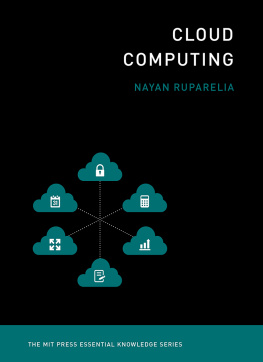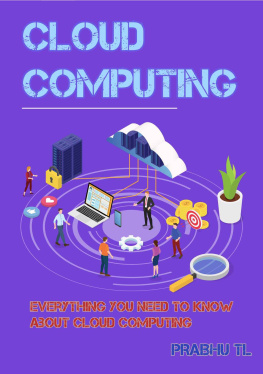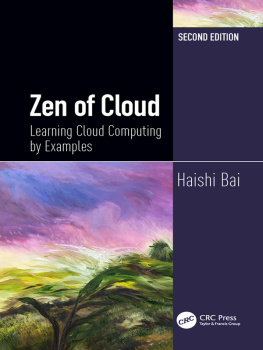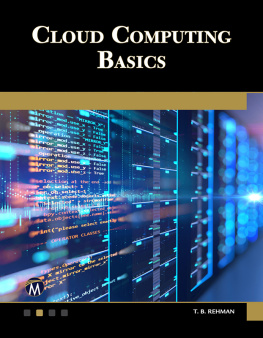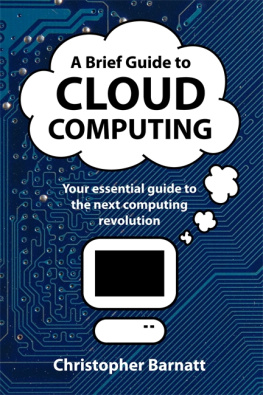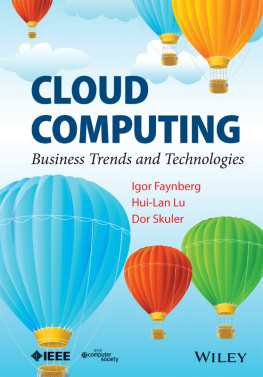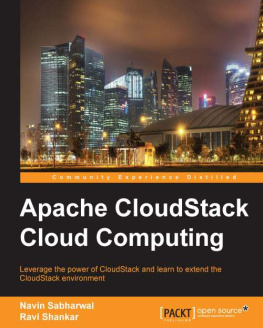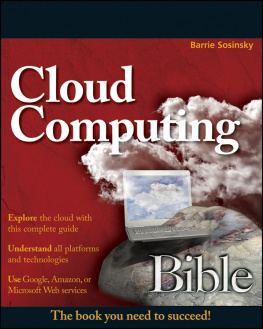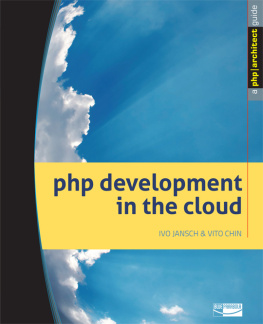Cloud
Computing
The MIT Press Essential Knowledge Series
Auctions , Timothy P. Hubbard and Harry J. Paarsch
Cloud Computing , Nayan B. Ruparelia
Computing: A Concise History , Paul E. Ceruzzi
The Conscious Mind , Zoltan L. Torey
Crowdsourcing, Daren C. Brabham
Free Will , Mark Balaguer
Information and the Modern Corporation , James W. Cortada
Intellectual Property Strategy , John Palfrey
The Internet of Things , Samuel Greengard
Memes in Digital Culture , Limor Shifman
Metadata , Jeffrey Pomerantz
MOOCs , Jonathan Haber
Open Access , Peter Suber
Paradox, Margaret Cuonzo
Understanding Beliefs , Nils J. Nilsson
Waves , Frederic Raichlen
Cloud
Computing
Nayan B. Ruparelia
2016 Massachusetts Institute of Technology
All rights reserved. No part of this book may be reproduced in any form by any electronic or mechanical means (including photocopying, recording, or information storage and retrieval) without permission in writing from the publisher.
Set in Chaparral Pro by the MIT Press.
Library of Congress Cataloging-in-Publication Data
Names: Ruparelia, Nayan, author.
Title: Cloud computing / Nayan Ruparelia.
Description: Cambridge, MA : The MIT Press, [2015] | Series: The MIT Press
Essential Knowledge Series | Includes bibliographical references and index.
Identifiers: LCCN 2015039870 | ISBN 9780262529099 (pbk. : alk. paper)
Subjects: LCSH: Cloud computing. | Cloud computing--Security measures.
Classification: LCC QA76.585 .R87 2015 | DDC 004.67/82--dc23 LC record available at http://lccn.loc.gov/2015039870
ePub Version 1.0
Contents
Series Foreword
The MIT Press Essential Knowledge series offers accessible, concise, beautifully produced pocket-size books on topics of current interest. Written by leading thinkers, the books in this series deliver expert overviews of subjects that range from the cultural and the historical to the scientific and the technical.
In todays era of instant information gratification, we have ready access to opinions, rationalizations, and superficial descriptions. Much harder to come by is the foundational knowledge that informs a principled understanding of the world. Essential Knowledge books fill that need. Synthesizing specialized subject matter for nonspecialists and engaging critical topics through fundamentals, each of these compact volumes offers readers a point of access to complex ideas.
Bruce Tidor
Professor of Biological Engineering and Computer Science
Massachusetts Institute of Technology
Preface
Not many people know what cloud computing is. Despite the hundreds of books and articles that have been written on the topic, few actually understand cloud computing. Sometimes, I feel, this applies to even the authors themselves. One of the reasons is that most of the books and articles discuss cloud computing from a highly technical viewpoint, instead of a users one. Another is the marketing hype that various businesses have created to use cloud computing as a selling point. This has led to a lot of confusion. This situation is common whenever a new technology enters the fray, and especially one that is bound to create a major paradigm shift. The purpose of this book therefore is to cut through the hype and show you how you can take advantage of cloud computing.
You could be an investor who wants to learn more about the cloud-based technologies produced by the business you invest in, an entrepreneur who wants to use cloud computing to ramp up your start-up in an agile manner, a lawyer or judge working on a case that relates to cloud computing, a technologist who wants to use cloud computing in a new product or service that you are defining, a business student who wants to understand the paradigm shift that cloud computing represents to businesses globally, or a layperson who is curious about the subjectthis book is for you. This book will help you understand cloud computing from a users standpoint: when to use it and when not to, how to select a cloud service and how to incorporate it with other cloud services or traditional IT, and what best practice is when using cloud computing.
As far as possible, I have refrained sfrom considering commercial cloud services or offerings in this book for three main reasons: (1) if one is not careful, the book can become an advertisement for various cloud service providers; (2) some vendors are here today and gone tomorrow, as is the nature within the fast-paced technology industry; and (3) the principal aim of this book is to provide concepts that will equip you to better make your own decisions about such offerings in the first place.
This is not a technical book. It is a book written primarily for a nonspecialist, although a technical specialist should benefit from reading this book in order to understand the broader impact and considerations of cloud computing. Thus no prior knowledge of cloud computing or any of its related technologies is required in reading this book. I advise strongly, however, that you read the first chapter of this book first so that we may have a shared, common vocabulary and understanding of cloud computing. This will prove useful when you read the succeeding chapters. You may read any of the chapters of the book in any order after going through the first chapter.
Roadmap
Chapter 1 provides an overview of cloud computing. It provides a definition and discusses each component that makes up that definition. It also considers the merits of cloud computing and provides a brief idea of some of its applications. It concludes with a discussion of the various players, or stakeholders, that participate in the cloud computing value chain.
Chapter 2 builds on the introduction of chapter 1 by describing the types of cloud computing in terms of its abstraction and deployment models. It further compares and contrasts the models component characteristics using new concepts that I have developed such as cloud patterns and cloud cells. These show how specialist clouds can be built, or used, in order to address specific use cases. Concepts from object-oriented design (OOD) are then borrowed to create relationships between these specialist clouds, called cloud cells. Thus a large variety of clouds for various use cases can be built by re-using the cloud cells and defining their interrelationships. This culminates with the discussion of use case patterns.
Chapter 3 asks a pertinent question: why cloud computing? What benefits does it provide, when should you use it, and what impact will it have on you, your work, your society, and your life? The chapter considers various concepts such as the personal cloud and the cloud of things.
Chapter 4 is a more objective version of chapter 3, especially from a financial perspective. This chapter will help you understand the various price models that cloud vendors can have. It is your toolkit for comparing price and value received from different cloud services and their vendors.
Chapter 5 considers Security and Governance. Not only is this subject topical given the various security breaches we have heard about, but is especially important when considering cloud computing. Topics such as security containers, monitoring, data integrity, data loss prevention, data privacy, data sovereignty, and legal and compliance issues are considered. Appended to the chapter is a section that explains common security terms used by specialists within the industry.
Chapters 6 to 9 inclusive consider use case patterns that were first introduced as a concept in chapter 2. The patterns are discussed in terms of the various abstraction levels of cloud computing: (a) Infrastructure and Platform, (b) Software, (c) Information, and (d) Business Process. These four chapters share a common template: examples of use case patterns are discussed for the abstraction level followed by a SWOT analysis and a key take-away section.

